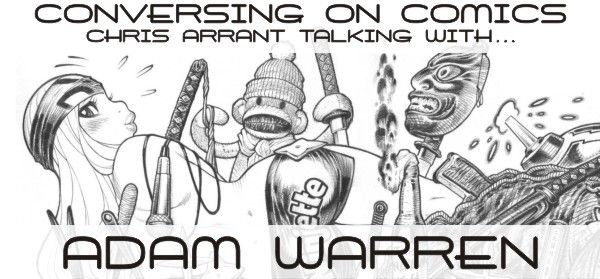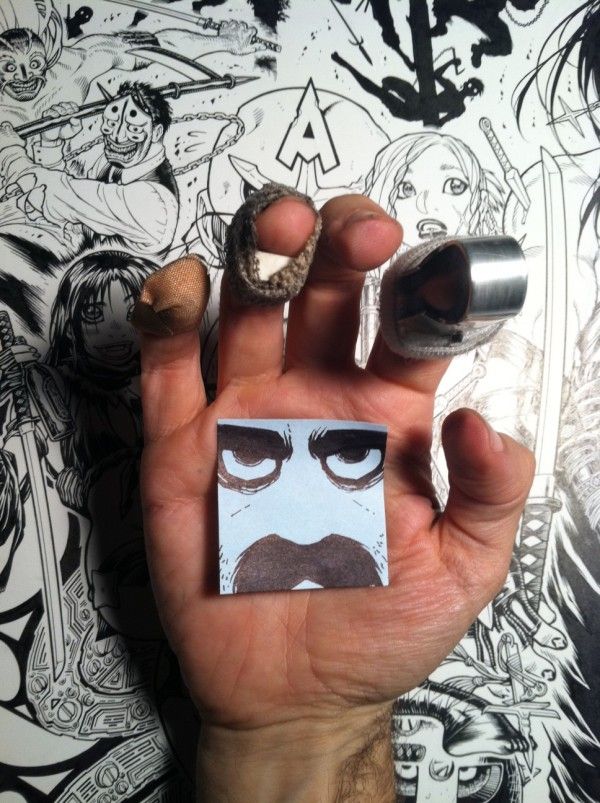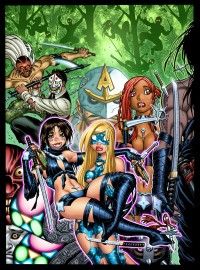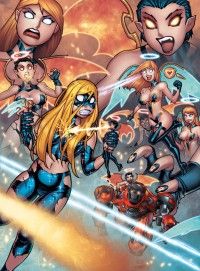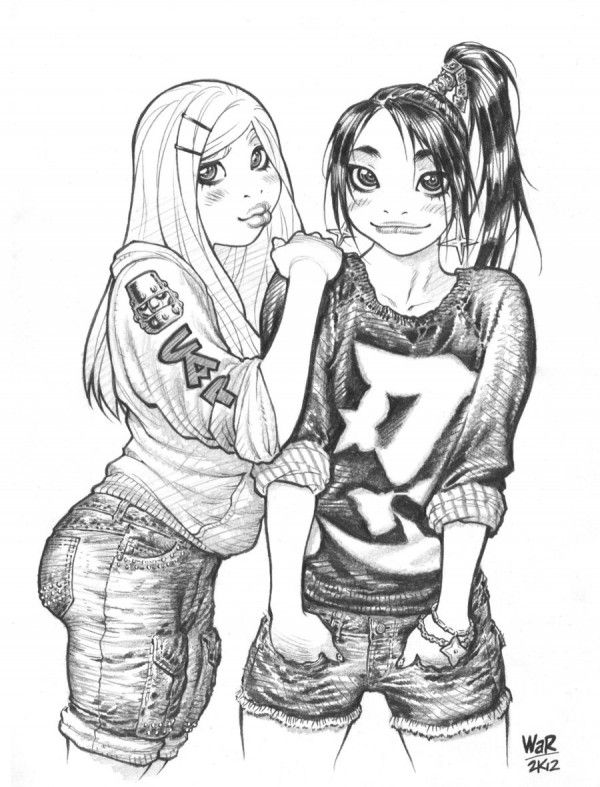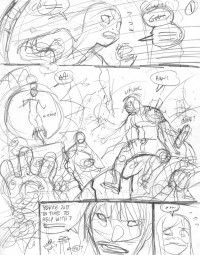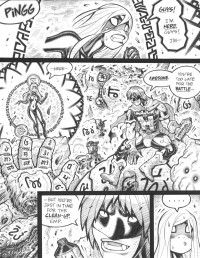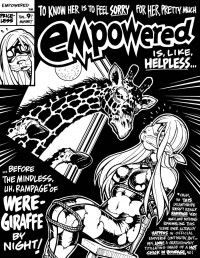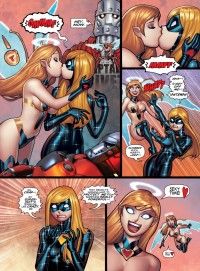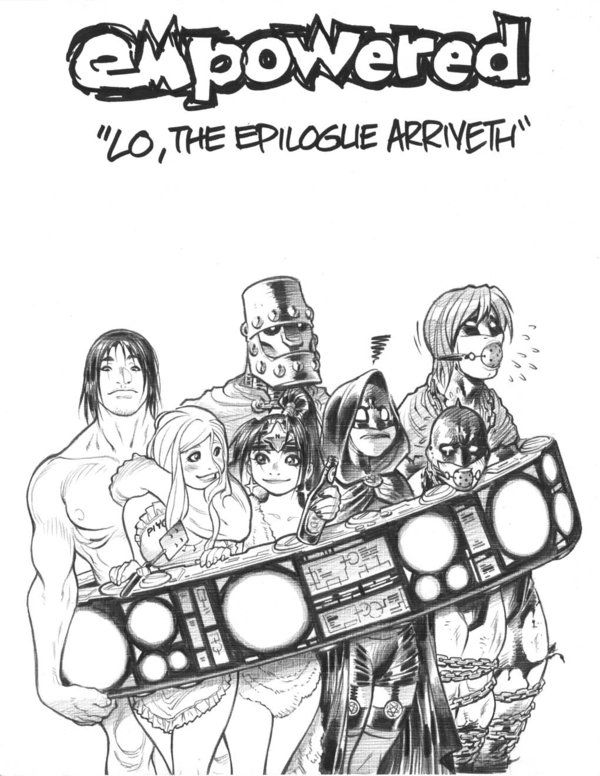What do you do when you combine a love for '70s American comics, training at the Joe Kubert School and a passion for manga? Adam Warren (@EmpoweredComic), that's what you get. And since graduation from Kubert in 1988, the New England artist has forged his own path in comics that's classic and exotic, and all-around fun.
For the past five years, Warren has spent the majority of his working (and waking) hours on his creator-owned series Empowered, published by Dark Horse. Described as an "episodic sexy superhero comedy," it follows the titular superheroine who wears a skintight costume that strengthens and weakens based on her relative self-esteem. With body issues, personal issues and the whole crime-fighting thing, her esteem is far from invincible. Emp, her boyfriend Thugboy and BFF Ninjette fight crime and spend their down time together in various states of anger, happiness and undress.
Empowered is de facto second act for Warren, who rose to fame importing and re-writing and drawing the manga/anime series Dirty Pair. Since then, he's branched out to work as a writer and an artist for DC Comics and Marvel, but he continues to find the greatest success on his own on series like Empowered. I spoke with Warren this month about the longevity of Empowered, the new one-shot with guest artist Ryan Kinnaird, and Warren's own issues of being a writer/artist, an artist and sometimes just a writer.
Chris Arrant: Let’s peek inside your workday – what are you working on today, Adam?
Adam Warren: Presently, I'm flailing my way through Page 19 of a story from the upcoming Empowered, Vol. 8, while working on script revisions for a new Empowered "Guest Artist" one-shot comic, while also nibbling away at lettering corrections on my own pages from said comic. In truth, today's a relatively low-key workday, as I often have more than a mere three jobs under way at the same time. (Nowadays, freelancers definitely need to be adept at keeping quite a few plates a-spinnin', if you follow me. Spin, plates of temporary employment, spin!)
Empowered has grown from being a fun joke to a serious book and now a serious career for you, Adam. … It outpaced Dirty Pair as your biggest project to date some time ago. At what point did you realize this was more than just a one-off book but was barreling into something bigger?
Well, by the time I'd breezed through the first 300-odd pages that would eventually become Empowered, I realized that this goofy little project could be "a real comic" after all. Nonetheless, I didn't have a great deal of ambition for the series beyond having a little fun and playing around with low-stakes, low-stress comics work. Back then, I saw the series as a whimsical side project, as "a real comic" of sorts but definitely not — ahem — "A REAL COMIC," if you'll excuse the capitalization indicating the term's Great Import and Seriousness.
After all, I was just casually scrawling Empowered's pages on 8.5-inch by 11-inch copy paper with little planning or forethought, the pages carelessly flowing wherever I felt a given story was taking me. By contrast, I thought that A REAL COMIC would be painstakingly drawn on full-size 10-inch by 15-inch comics art board, demanding tedious, grinding, repetitive art stages — roughs, tight layouts, tighter pencils, even tighter inks, lettering, coloring, corrections and so on. A REAL COMIC would require elaborate, meticulous planning stages — plot, detailed story outline, finished script — and be locked into a rigid, inflexible format — a 22-page issue, say. In my previous experience, A REAL COMIC might be fun to read, but was certainly never much fun to produce. The idea that drawing A REAL COMIC might, in fact, be a free-flowing, organic, non-tiresome experience was completely alien to me.
Right up through Empowered, Vol. 3, or so, I kept noodling away haphazardly at the series while trying — and, for the most part, failing — to line up other, better-paying work. (I should note that Empowered's early production was subsidized by my occasional forays into mainstream-comics work and semi-lucrative stumbles into commercial-art jobs.) Then I gradually, dimly became aware that the stories had taken on some unplanned depth and complexity, with plot threads such as Thugboy's checkered past as a guerilla "capekiller" and Ninjette's even more checkered background evolving in intriguing new directions. More importantly, the cast's characterization was developing apace as well, with new ideas for even previously neglected, one-note characters constantly popping into my head. ("Hey, what if blonde-ophobic Sistah Spooky had a telepathic ex-girlfriend, who just happened to be blonde herself?")
So, yeah: To my surprise, despite the series' inherent goofiness and highly dubious origins, Empowered had somehow bootstrapped itself up to the status of A REAL COMIC. Admittedly, I would've appreciated knowing that from the beginning — certain, shall we say, narrative excesses probably would've been minimized or left out of Empowered entirely — but, hey, no point in crying over spilled milk.
From one-off book to series, you and Dark Horse are now grooming it to be a “franchise,” so to speak, with the floppy Empowered Specials. Can you describe for us the transition into really committing to Empowered as this big thing?
Gotta say, I've been pretty committed to Empowered as a big thing for rather a while, now. The difference, at this point, is that I'm scheming to maintain a more constant presence for Empowered on the shelves — and in readers' hearts! — during the unavoidably long gap between full volumes of the series. To that end, I'm writing a new series of "floppy"-format Empowered one-shots, featuring art by an elite — nay, élite — group of Talented Guest Artists, along the lines of the Empowered: 10 Questions for the Maidman special that Talented Guest Artist Emily Warren worked on in 2011.
If the one-shots sell decently enough, I might even try to pitch Dark Horse on doing an actual Empowered Guest Artist-drawn miniseries — gasp! — but, well, let's not get ahead of ourselves here. To put it mildly, Empowered doesn't quite boast the prestige and/or profile of a Dark Horse mainstay like, say, Hellboy, so perhaps I should hold off on blue-skying such vainglorious schemes for the time being. So, for now, I'll just bellow, "Full speed ahead on Empowered one-shots!"
So we should expect more Empowered Specials in the near future?
Yeah! The newest one-shot's just been solicited by Dark Horse, I'm happy to report. Empowered Special #3: Hell Bent or Heaven Sent is a "floppy"-format comic shipping on Dec. 19, featuring resplendent, luxuriously full-color artwork by Talented Guest Artist Ryan Kinnaird — and some less-resplendent B&W artwork by me, as well. Here's the book's scintillating solicitation copy: "This time around, the 'sexy superhero comedy' ensues when costumed crimefighter Empowered makes an ill-fated visit to a top-secret dumping ground for ultra-tech 'superdebris' and wrecked 'villainware' left over from cape-on-cape battle. Can our heroine and her hapless teammate, cyborg-with-a-secret Mechanismo, possibly hope to survive when the junkyard begins nano-spawning an apocalyptic cheesecake plague of flirty but lethal 'cyber-angels' and sensual but savage 'devil mecha'?"
But wait! There's more stuff I couldn't mention in the solicitation copy! Hell Bent or Heaven Sent also includes: Literally super-hot gender-swapping! Fire-breathing jealousy and piercing blue eyes as more than just figures of speech! Jet-propelled mecha body-boarding! Grotesque mastication by 100-foot-tall giants! The laser-scanning male gaze revealed! Hot angel-on-ladycape action! Desperate navigation of a hellishly unhelpful help menu! Emp suffers the agony of high heels! The imminent threat of searing, fiery extinction looms nigh! All this, plus something very, very gross is none-too-subtly hinted at!
I wrote the whole thing — all 30 pages of story, I hasten to boastingly clarify! — and, as I did on Emily's Maidman one-shot, I drew additional comic pages sketching in story-relevant background detail. The majority of the book's artistic heavy lifting, however, is provided by the thoroughly badass and lusciously colorful artwork of my old buddy Ryan Kinnaird, who's worked with me on projects ranging from Dirty Pair and Gen13 to Livewires and — go figure! — Empowered. In comics, he's arguably best known for creating the somewhat infamous miniseries Phoenix: Legacy of Fire for Marvel, and more recently the cheesecake-heavy video game parody Next-Gen Wars for Image. I'm kinda "steering into the skid" with a story tailored specifically to Ryan's beautifully rendered artistic oeuvre, as Hell Bent or Heaven Sent deals directly with issues of soulless cheesecake and objectification both figurative and literal.
Like most talented, clue-possessing artists nowadays — unlike, say, myself — Ryan's mainly been doing game-related art and design work for the last few years, so I'm quite happy that I wheedled him into a brief return to the less-lucrative world of comics production. That's one of the manifold cruel ironies of the comics field, by the way: If you manage to develop the wide and varied skill set necessary for drawing comics well, I've found that actually drawing comics is by far the least financially rewarding use of that hard-won skill set. Money-wise, most highly capable artists are invariably much better off storyboarding for animation or character designing for video games or the like than messing around with low-pay, high-stress comics piecework. Oh, the cruel, cruel irony …
Beyond Ryan's Hell Bent or Heaven Sent story, other Empowered one-shots are underway as well, even as I approach other Guest Artists to line up future issues. One particular book is rather far along — I'd describe it as "Die Hard with mecha, at an alternate-universe superhero car show" — but I really shouldn't talk about that one-shot in detail until it's formally announced.
On Twitter you mentioned the subtitle “Hell Bent or Heaven Sent” was a title you had laying around from the Dirty Pair days. You also said one time that Emp’s suit was inspired in part by something you had for the girls in Dirty Pair. Overall, can you tell us how your work on DP bubbles up in Empowered?
I'd say that, in terms of humor and the occasional science-fiction riff — and, yes, the cheesecakery — Empowered does feature a little bit of the old Dirty Pair flavor. An example: Emp's body-shamed chagrin about her allegedly chubby behind happens to be the direct opposite of Kei's boastful pride in her "acclaimed Hypno-Butt," from which all are helpless to look away.
Note that I'm normally very careful not to go too crazy with the aforementioned SF elements in Empowered, as the book has a wider and more varied readership than the SF-skewed Dirty Pair audience, and I've learned the hard way that I can lose readers when I dial up the SF level too far. I should say, though, that much of my mainstream work was considerably more influenced by ideas I'd worked up for unused Dirty Pair stories. The miniseries I wrote for Marvel, Livewires and Iron Man: Hypervelocity, featured plenty of ultra-high-tech riffs and outré SF concepts that were originally created for Kei and Yuri adventures, as did Wildstorm/DC's Gen13 and Titans: Scissors, Paper, Stone.
I used this interview as an excuse to re-read Empowered, Vol. 7, and I have to say it was quite more violent with the Ninjette scenes than previous volumes. Should readers expect darker and more violent moments in future volumes?
Gotta say, it's no big spoiler alert to say that dark and/or violent moments are in store during future Empowered volumes. That doesn't mean, however, that the series will degenerate into one long, glum, humorless slog through grimness and gore. I say thee nay, a thousand time times nay! (Sorry, just reread the Lee/Kirby Mangog arc in Thor yesterday.) Rather, Empowered will continue to be a largely humorous, warm-hearted book that occasionally takes sudden, alarming detours into harsh, coldblooded intensity.
Example: Empowered, Vol. 8, is arguably a fun and frolicsome read right up until the book's concluding story, wherein Empowered and her former rival Sistah Spooky embark on a uniquely frightening field trip to both the airless void of outer space and the infernal depths of hell itself. At that point, all bets are off as apocalyptic alien encounters, torturously hellish hijinks and relentless, over-emotional tearjerkery become the order of the day!
This whiplash-tastic approach to narrative tonal shift is why my standard tagline for describing the series goes as follows: "Empowered is a sexy superhero comedy — except when it isn't."
Empowered has taken up most of your time, but do you have room or the design to do anything outside of Emp, Ninjette and the gang?
As the art process is so relentlessly drawn-out (har, har!) and protracted, I generally don't have enough spare time to draw comics other than Empowered. I do, howeva, have enough spare time to write other projects and draw occasional non-comics artwork, both of which I've been doing off and on for most of this year. As much as I enjoy working on Empowered, I have other narrative itches I'd like to scratch; seeing strong work like Brandon Graham's Prophet run makes me wanna do some straight-up SF in comics form, for example.
In truth, not only do I want to work on projects other than Empowered, I even want to work on Empowered projects other than the regular volumes and one-shots... Hence the several different Top-Secret Empowered Side Projects I've been working on this year! One of the Secret Emp Side Projects is pretty far along, I can say; another's effectively defunct, but I should probably refrain from discussing it; and a third is still in the very earliest of planning stages. So, yeahp, I'm hopeful that readers can look forward to Empowered goodness in new and exciting forms… though not anytime particularly soon, I'm afraid.
Reading interviews with you and following your career online, I can feel your desire to do more comics writing where someone else does the drawing. As someone who is so well known for his drawing ability and drawing style, what’s it like to try to establish yourself as “just" a writer?
In fairness, I've been doing "writer-only" work for quite some time now, dating back to a 1999 Gen13 story I wrote for then-Wildstorm wunderkind Lee Bermejo to draw. That first collaboration with an artist worked out so amazingly well that, to be honest, I probably developed an unrealistic view of how utterly awesome all subsequent writing jobs would turn out to be. Still, I'd have to say that every subsequent writing job was awesome to a surprising degree, as telling other, better artists what to draw is always much more fun than having to draw something myself!
However, brace yourself for a startling revelation: I've discovered that lining up writing work in mainstream comics is an extremely demanding and problematic challenge! Or, if you prefer, "a demandingly extreme and challenging problem!" Fun with word order! (Not, by the way, that writing gigs are all that much easier to nail down in non-mainstream comics, either.) Like any other aspiring comics writer — and lordy loo, are there ever a lot of 'em, to the point that the comics field sometimes seems to have more aspiring writers than actual readers — I'm always nosing around for another opportunity.
Come to think of it, my success rate at lining up writing work has dropped off sharply since Empowered debuted. This might be because editors assume I'm too busy drawing Emp to take on outside work — which is emphatically not the case, I hasten to assure potential editors!
One option I've tragically neglected, alas, is working up further creator-owned projects for other artists to draw. Even though it's essentially career malpractice for a comics writer not to work up original projects, I've dithered over pursuing that route mainly because of concerns over getting potential artists compensated adequately. I know all too well exactly how maddeningly difficult and time-consuming the process of drawing comics can be, so I've generally been loath to engage artists on projects that won't pay very well. Empowered, for example, wouldn't have existed if I hadn't drawn the books myself; I couldn't, in good conscience, have asked another artist to work for the rather meager advances inherent to the series' unforgiving original graphic novel format. (I hasten to note that the available page rates on the floppy-format Empowered one-shots are much, much more acceptable. As in, "MUCH.") Still, in the near future I'm hoping to get some other new, original comics projects a-rolling, assuming I can keep the rest of the potential creative team from getting financially hosed.
I imagine you having trouble like the way George Clooney would trying to produce movies – the conversation would always turn into “why don’t you star in it too, George?” and in your case, “Why don’t you draw it too, Adam?”. Do you get that, or is my imagination just running wild?
That still happens from time to time, but most editors—if , that is, they're aware of me at all—have heard by now that I rarely have much availability for—or interest in—actually drawing comics. Writing comics, on the other hand, is something that I'm always available for and interested in (he said loudly, in the hopes of editors overhearing him).
I'm actually quite pleased to occasionally hear from readers who don't particularly care for my artwork, but do appreciate my writing. The rarely encountered opposite—readers who do like my art, but don't like my writing—pleases me not at all, I'm afraid. That's likely because I consider myself more of a writer who happens to have art skills than a true-blue, happy-just-to-draw "real artist" as such.
Some people see you as a manga-styled American artist, but you were born and raised on American classics like Buscema and Kirby, and studied under Joe Kubert. How do you think having that “base” so to speak before you incorporated more Japanese elements effected you, especially in working to make a career in American comics?
With my initial influences being old-school American titans like you mentioned — as well as artistic stalwarts of the '80s alt-comics scene like Dave Stevens, Howard Chaykin and Steve Rude — I wound up in an unusually advantageous position when I began incorporating manga influences into my comics pages. That is, my work was already action-oriented and dynamic — if you'll excuse the self-puffery — in a relatively mainstream-accessible manner, thanks to my earlier influences; thus, my integration of Japanese character-design approaches and storytelling techniques wasn't as off-putting as it might otherwise have been to readers and editors unfamiliar with manga.
Plus, hey, I was making comics featuring cute girls, high-tech hardware and over-the-top action, which wasn't an especially tough combination to sell to American comics readers and retailers. I would've faced a much, much harder time of things debuting in the late-'80s comics field if, say, I were strongly influenced by shoujo (girl's) manga instead of shounen (boy's) manga. Not that I enjoyed an especially striking degree of success back then, as the early-'90s boom period passed me by entirely while I was working on Dirty Pair; in a time when million-selling books roamed the land like collector-fueled colossi, I was never able to get DP to sell much out of the 20K range. (Hell, Kei and Yuri never even benefited from the godawful "bad girl" boomlet, despite being very bad girls indeed.) Still, I would've enjoyed even less — far, far less — success back in the day if my specific combination of influences wasn't quite so "mainstream-friendly," I have to admit.
In an interview over at About.com, you talked a little bit about how females, in generally, are more interesting to you as characters than men. As a storyteller, is that something that’s been a part of you from the beginning or did you have a point in your career where it clicked?
Early on, I started drawing the Dirty Pair because, honestly, I couldn't draw female characters if my life depended on it, so I figured I'd best start learning. Only later, once I was semi-decent at drawing Kei and Yuri, did I start concerning myself about writing them as fully developed characters. (Odd side note: My earliest idea of the DP's personalities was based on laughably inaccurate and wildly off-base ideas gleaned from watching untranslated anime; in the end, this turned out to be for the best, goofily enough.) I had a lot of fun back then, trying to shade and color badass action heroines with traits and tendencies shared by real-life women I knew at the time. The results might've been uneven, but overall I'm pleased with the degree of characterization Kei and Yuri were given — even if I might handle things a bit differently nowadays.
Later in my career, the miniseries Gen13: Magical Drama Queen Roxy was a major turning point, in that I had to establish the point of view of a much more flawed and relatable female character than action-heroine forces of nature like Kei and Yuri. (Go figure: Empowered is descended in large part from MDQRoxy's portrayal of a deeply if not maddeningly insecure superheroine.)
What comics/manga are you reading now that interests you?
On the American side of things, I do my bit to drop by the comics store and support creator-owned books I enjoy, such as the aforementioned Prophet by Graham/Roy/Milonogiannis/et al, Joe Keatinge and Ross Campbell on Glory, Jim Zubkavitch and Edwin Huang on Skullkickers, Ken Garing's Planetoid and so on. Most of my other Western comics purchases are in TPB form, such as straight-to-trade work by Carla Speed McNeil, Bryan Lee O'Malley, Svetlana Chmakova, Ross Campbell (there he is again!), Faith Erin Hicks, Jen Wang and other cartoonists of that "unstoppable creative ball o' fire" sort.
Manga-wise, here are a few titles I snap up, whenever possible: Naoki Urasawa's evergreen 20th Century Boys, Koji Kumeta's strangely compelling Sayonara, Zetsubou-Sensei, Hiroaki Samura's perpetually impressive Blade of the Immortal, Kio Shimoku's always entertaining Genshiken, Oh! Great's demented yet artistically stunning Air Gear, Tetsuro Ueyama's wildly kinetic Solevision Mitsuyoshi, and Ken Akamatsu's badass-once-you-get-past-the-fan-service Negima!
When news came out of Joe Kubert’s passing, your name popped up to me because you’re one of the most memorable artists to come from that school to me. I’m not looking for a eulogy or anything of Joe, but can you recall any special moments you had with Joe during your time there or after that made an impact on you?
If you'll pardon the recycling, here's a bit I wrote about Joe over at my deviantART page:
R.I.P. Joe Kubert, the much-loved comics-art icon and founder of the namesake Kubert School, where he simultaneously managed to be both the most intimidating and the most approachable of all my teachers. In my mind's eye, I can still see him rubbing his beard contemplatively, breezily dashing off a perfectly inked gorilla head — without any pencils! — on scrap paper, chuckling and telling my friend Tom Raney, "You do love to draw, Tom," or delivering his patented bone-crushing handshake.
Gotta admit, in my Narrative Art assignments for Joe, I nursed a somewhat twisted ambition: I wanted to do such a badass job on my comics pages that Joe would have nothing to point out about 'em during his critique. (PROTIP: Scheming specifically to not get feedback from your ultra-knowledgeable comics-vet teacher is a rather counterproductive use of your time as an art student.) That rarely happened, of course — which was certainly for the best, given that I always learned a great deal from Joe's critiques. Still, it's amusingly odd to consider that, in effect, he posed both an indirect and a direct influence on my work, which is the sort of art-related paradox that only an comics titan like Joe could embody; makes me kinda glad, recalling that my art-school diploma has a Kubert-inked illo of Tor the caveman on it.
Oh, and here's an odd anecdote from one Joe critique: Well into my (ongoing!) phase of manga-influenced artwork, I drew a faux cover illo for an art assignment. Looking it over, Joe suggested, "Your composition needs more tension." (Contemplative beard rub.) "What if, say, you drew a tentacle reaching in from off-camera and grabbing your heroine's wrist?" Needless to say, in those innocent, naïve days of the carefree 80s, neither Joe nor I had any idea that the words "manga" and "tentacle" would one day take on a very different and entirely more ominous implication...
One last thing I wanted to ask you about was your lettering. I can count on my hands the number of books that use hand-lettering these days, so I have to ask: What motivates you to keep hand-lettering, straight onto your art board even?
I hand-letter Empowered primarily as a time-saving measure; then again, almost everything about the book's production approach is a time-saving measure, come to think of it. Anyhoo, hand-lettering speeds up my comics process for two reasons: 1) I can arguably scrawl lettering — well, word-balloon copy and sound effects, at least — faster by hand than I could if I used computer-lettering software. At worst, hand-lettering might be a little bit slower. 2) More importantly, as I letter each panel before I start drawing its final artwork, the word balloons often block out entire swathes of background detail that I'd otherwise have to draw. Over the course of an Empowered volume's 208-plus pages, those background-obscuring balloons probably save me the equivalent of at least 30 to 40 pages worth of effectively pointless artwork that would've ended up concealed by dialogue, regardless.
Note that this effect is amplified by the fact that my lettering is quite large, due to the small size of my originals (again, 8.5 inches by 11 inches) and the rather crude tools I letter with; big, very soft (6B hardness) pencil leads do not lend themselves to wee, delicate font rendering. Not that I have a problem with this, given that I want my lettering to be as bold, clear and readable as possible. (I have naught but withering scorn for the maddening comics trend of inexplicably tiny and unreadable fonts used in modern computer lettering, but that's a whole 'nother rant.)
Beyond that, what can I say? For some reason, I kinda like lettering by hand. (It certainly beats drawing extra backgrounds, I can assure you.) I'm no lettering savant like Tom Orzechowski or Todd Klein or the similarly über-skilled like, but I tend to enjoy the way my wonky, pencil-scribbled dialogue, balloons and sound FX work out, flawed though they might be. Plus, lettering gives me a cheaply earned sense of accomplishment, even though it's by far the easiest and least time-consuming aspect of my production process.
Next week, Chris Arrant's Conversing on Comics returns with comics wunderkind Sam Humphries. In just one year, this California-based writer has gone from comics rookie to comics elite, writing two major series for Marvel while keeping his voice and vision alive on the independent comics scene. From his unlikely comics debut in Casanova to his time at Myspace and on to making his love real and making Captain America the President of the United States, Humphries tells all.

